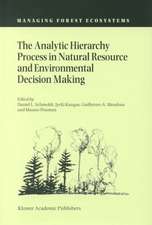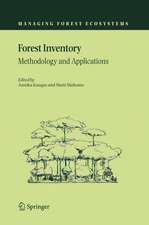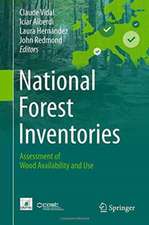Decision Support for Forest Management: Managing Forest Ecosystems, cartea 30
Autor Annika Kangas, Mikko Kurttila, Teppo Hujala, Kyle Eyvindson, Jyrki Kangasen Limba Engleză Hardback – 5 noi 2015
| Toate formatele și edițiile | Preț | Express |
|---|---|---|
| Paperback (1) | 945.79 lei 6-8 săpt. | |
| Springer International Publishing – 23 aug 2016 | 945.79 lei 6-8 săpt. | |
| Hardback (1) | 956.81 lei 3-5 săpt. | |
| Springer International Publishing – 5 noi 2015 | 956.81 lei 3-5 săpt. |
Din seria Managing Forest Ecosystems
- 18%
 Preț: 945.79 lei
Preț: 945.79 lei - 18%
 Preț: 1394.03 lei
Preț: 1394.03 lei -
 Preț: 367.69 lei
Preț: 367.69 lei - 18%
 Preț: 1113.71 lei
Preț: 1113.71 lei - 15%
 Preț: 642.21 lei
Preț: 642.21 lei -
 Preț: 431.74 lei
Preț: 431.74 lei - 24%
 Preț: 1042.44 lei
Preț: 1042.44 lei - 15%
 Preț: 711.21 lei
Preț: 711.21 lei - 24%
 Preț: 787.54 lei
Preț: 787.54 lei - 15%
 Preț: 646.62 lei
Preț: 646.62 lei - 15%
 Preț: 645.60 lei
Preț: 645.60 lei - 18%
 Preț: 1242.03 lei
Preț: 1242.03 lei - 15%
 Preț: 648.24 lei
Preț: 648.24 lei - 15%
 Preț: 693.90 lei
Preț: 693.90 lei - 24%
 Preț: 799.28 lei
Preț: 799.28 lei - 18%
 Preț: 1229.10 lei
Preț: 1229.10 lei - 18%
 Preț: 943.43 lei
Preț: 943.43 lei - 18%
 Preț: 948.92 lei
Preț: 948.92 lei - 24%
 Preț: 778.95 lei
Preț: 778.95 lei - 18%
 Preț: 945.62 lei
Preț: 945.62 lei - 18%
 Preț: 943.88 lei
Preț: 943.88 lei - 18%
 Preț: 1544.00 lei
Preț: 1544.00 lei - 18%
 Preț: 946.55 lei
Preț: 946.55 lei - 18%
 Preț: 1244.71 lei
Preț: 1244.71 lei - 18%
 Preț: 949.73 lei
Preț: 949.73 lei - 18%
 Preț: 967.08 lei
Preț: 967.08 lei - 24%
 Preț: 849.91 lei
Preț: 849.91 lei - 24%
 Preț: 903.02 lei
Preț: 903.02 lei - 18%
 Preț: 952.26 lei
Preț: 952.26 lei - 20%
 Preț: 592.63 lei
Preț: 592.63 lei
Preț: 956.81 lei
Preț vechi: 1166.84 lei
-18% Nou
Puncte Express: 1435
Preț estimativ în valută:
183.11€ • 190.46$ • 151.17£
183.11€ • 190.46$ • 151.17£
Carte disponibilă
Livrare economică 25 martie-08 aprilie
Preluare comenzi: 021 569.72.76
Specificații
ISBN-13: 9783319235219
ISBN-10: 3319235214
Pagini: 307
Ilustrații: XIII, 307 p.
Dimensiuni: 155 x 235 x 25 mm
Greutate: 0.77 kg
Ediția:2nd ed. 2015
Editura: Springer International Publishing
Colecția Springer
Seria Managing Forest Ecosystems
Locul publicării:Cham, Switzerland
ISBN-10: 3319235214
Pagini: 307
Ilustrații: XIII, 307 p.
Dimensiuni: 155 x 235 x 25 mm
Greutate: 0.77 kg
Ediția:2nd ed. 2015
Editura: Springer International Publishing
Colecția Springer
Seria Managing Forest Ecosystems
Locul publicării:Cham, Switzerland
Cuprins
1. Planning and Decision Support.- 2. Forest Management Planning.- 3. Single-Criteria Problems.- 4. Multi-Criteria Decision Problems.- 5. Uncertainty in Multi-Criteria Decision Making.- 6. Linear Programming and its Extensions in Forest Planning.- 7. Heuristic Optimisation.- 8. Uncertainty in Optimisation.- 9. Participatory Planning and Group Decision Making.- 10. Voting Methods.- 11. Participatory Planning Processes in Action.- 12. Behavioral Aspects.- 13. Final Remarks.
Recenzii
“This book is based on the research, lectures and real-life experiences of authors who all originate from Finland. … This book presents the advances and progress in the use of OR in forestry management over the last forty to fifty years. The substantial growth in the range of techniques, methods and approaches extensively shown through examples in the book Decision Support for Forest Management, should put forest managers and decision makers well equipped to face this challenge.” (Hans W. Ittmann, IFORS News, Vol. 11 (1), March, 2017)
Textul de pe ultima copertă
This book offers a thorough review and explanation of decision support methods and tools, and shows how these are best applied to a wide range of situations in the practice of sustainable forest management. The goal is to provide both students and working forest managers a toolbox of methods covering most of the decision situations encountered in practice.
The first chapter introduces basic concepts of planning, decision making and decision support. Chapter Two explores forest management as a planning problem, including definitions of sustainability, the development of approaches to optimisation; approaches to multi-criteria decisions; and the need for participatory planning. The third chapter covers single-criteria problems, showing how to measure utility and value, how to assess risk, and how to estimate a value function. A chapter on multi-criteria problems delves deeply into decision modelling, utility functions including SMART and TOPSIS, Analytic HierarchyProcess and more. Chapter Five addresses uncertainty in multi-criteria decision making, introducing fuzzy set theory, outranking methods such as PROMETHEE and ELECTRE, and probabilistic uncertainty using Stochastic Multicriteria Acceptability Analysis (SMAA). Chapter Six discusses linear programming and its extensions in forest planning. Chapters Seven and Eight go deeper still, discussing heuristic optimisation and uncertainty in optimisation. Chapter Nine address group decision making and participatory planning, including the roles of decision makers, stakeholders and facilitators. Chapter Ten addresses voting as a group decision making tool. Chapter Eleven examines participatory planning processes in action, as applied to specific contexts in forest management planning. Chapter Twelve is devoted to behavioural aspects of planning, decision making and participation, including concepts as ‘satisficing’ or ´groupthink’.
The concluding chapter offers the authors’ insights on how allthese concepts, tools and practices reflect the three worlds: material, personal and social.
This updated and expanded second edition adds the most recent advances in participatory planning approaches and methods, giving special emphasis to decision support tools usable under uncertainty. The new edition places emphasis on the selection of criteria and creating alternatives in practical multi-criteria decision making problems.
The first chapter introduces basic concepts of planning, decision making and decision support. Chapter Two explores forest management as a planning problem, including definitions of sustainability, the development of approaches to optimisation; approaches to multi-criteria decisions; and the need for participatory planning. The third chapter covers single-criteria problems, showing how to measure utility and value, how to assess risk, and how to estimate a value function. A chapter on multi-criteria problems delves deeply into decision modelling, utility functions including SMART and TOPSIS, Analytic HierarchyProcess and more. Chapter Five addresses uncertainty in multi-criteria decision making, introducing fuzzy set theory, outranking methods such as PROMETHEE and ELECTRE, and probabilistic uncertainty using Stochastic Multicriteria Acceptability Analysis (SMAA). Chapter Six discusses linear programming and its extensions in forest planning. Chapters Seven and Eight go deeper still, discussing heuristic optimisation and uncertainty in optimisation. Chapter Nine address group decision making and participatory planning, including the roles of decision makers, stakeholders and facilitators. Chapter Ten addresses voting as a group decision making tool. Chapter Eleven examines participatory planning processes in action, as applied to specific contexts in forest management planning. Chapter Twelve is devoted to behavioural aspects of planning, decision making and participation, including concepts as ‘satisficing’ or ´groupthink’.
The concluding chapter offers the authors’ insights on how allthese concepts, tools and practices reflect the three worlds: material, personal and social.
This updated and expanded second edition adds the most recent advances in participatory planning approaches and methods, giving special emphasis to decision support tools usable under uncertainty. The new edition places emphasis on the selection of criteria and creating alternatives in practical multi-criteria decision making problems.
Caracteristici
The only book that covers such a broad a scope of planning methods and methodologies, supported by comprehensive numerical examples The first forestry textbook that covers stochastic optimisation and provides numerical examples Introduces state-of-the art multi-criteria analysis methods linked to practical forestry examples Presents sound MCA methods, with recommendations and examples for practical application





















